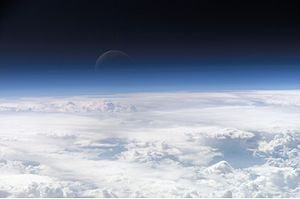Earth's atmosphere
The blue light wavelength in the atmosphere is more scattered to the atmosphere, giving blue light to the Earth, which was seen from the outer space of the ISS, which is 402-424 kilometers above.
According to the structure of the Earth's atmosphere. The pie chart below reveals that the found gases form 0.038% of the atmosphere. This amount is not collected from various years (mainly carbon dioxide in 1987 and methane in 2009) and does not refer to any single source.
Earth's atmosphere refers to the different mixed-mixing layers around the Earth, which hold the earth with its gravity. It is called the atmosphere. This atmosphere absorbs the ultraviolet rays coming from the sun and protects the existence of organisms on earth. Even with heat retention (greenhouse effect), the surface degrades the surface and reduces night temperature compared to day.
The common name given to atmospheric gases used for respiration and photosynthesis is air or air. In the dry air, 78.09% nitrogen in the air, 20.95% oxygen, [1] 0.93% aragon, 0.03% carbon dioxide and slightly There are other quantities of gas. But there is also variable amount of variable vapor in the amount of which is approximately 1%. The amount of air and atmospheric pressure can be found at different levels. Differs, terrestrial plants and terrestrial animals to survive in the wind and artificial bayumandalasamuhe trapomandala the world can be found.
The mass of the atmosphere is about 5 × 1018 kg, which is about 11 kilometers (36,000 feet 6.8 miles) on the surface of three quarters. With the increase of the atmosphere the atmosphere stays thin and there is no specific limit between the atmosphere and the space. The Karman line, 100 kilometers (62 miles), or 1.57% of the Earth's radius, is often used as the boundary between the atmosphere and the space. About 100 kilometers (62 miles) above sea level, or 1.57% of the Earth's radius is often used as the boundary between the atmosphere and the space. The atmospheric influences are observed when the space station passes over at the height of approximately 120 kilometers (75 miles) at the official line. Depending on the temperature and the structure, the atmosphere can be divided into several layers.
The study of the Earth's  and its process is called atmospheric science or aerology. Leon Teiseric de Burt and Richard Assmann are the pioneer pioneers of this science. [2]
and its process is called atmospheric science or aerology. Leon Teiseric de Burt and Richard Assmann are the pioneer pioneers of this science. [2].svg.png)